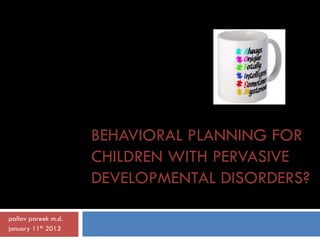
Behavioral Interventions in children with Pervasive Developmental Disorders
- 1. BEHAVIORAL PLANNING FOR CHILDREN WITH PERVASIVE DEVELOPMENTAL DISORDERS? pallav pareek m.d. january 11th 2013
- 2. Objectives Case discussion Journal Article: Discussion and exchange of ideas - Is a behavioral plan required? - Does a neurotypical behavioral plan work in PDD? - What modifications (if any) are required? - Resources in St. Louis Metro Area?
- 3. Autism Fact Sheet 1 in 88 children and 1 in 54 boys Autism is the fastest-growing serious developmental disability in the U.S. Autism costs a family $60,000 a year on average Autism receives less than 5% of the research funding of many less prevalent childhood diseases. 0.55% of total NIH funding. 40% of children with autism do not speak
- 4. Major areas of Target for ASD’s Behavior Social Communication
- 5. Some Challenging Behaviors in ASD’s • Aggression is a high-profile behavior that garners more attention • Is aggression a reaction to frustration Aggression and difficulty with appropriately communicating affect state or identifying alternative reactions to frustrating experiences • SIB is similar to (?) stereotypies with Self respect to the rhythmical and repetitive nature of the behavior, but Injurious in the case of SIB, tissue damage often results Behaviors
- 6. Trivia!! What is the average cost of ABA for a family per annum?
- 7. Some things that worked… Body Bag, Shredder App, Lifting Weights, Trampoline, Carrying pumpkins etc..
- 8. History of ABA Watson fed up with “hypothetico-deductivo reasoning”→Experimental Analysis of Behavior →B. F Skinner Initially known as Behavioral Mod Lovaas is one of the pioneers: In early years aversives (Strikes, shouting, shocks) 10 Now mostly positive reinforcers Judge Rotenberg Center (formerly Behavior Research Institute) Canton, Massachusetts In the initial studies by Dr. Lovaas11: There were claims of up to 47% children→ mainstream→ indistinguishable Remains the most popular and most evidenced based approach for Autism 10: Moser D, Grant A (1965-05-07). "Screams, slaps and love". Life 11:Lovaas, O. I. (1987). Behavioral treatment and normal intellectual and educational functioning in autistic children. Journal of Consulting and Clinical Psychology, 55, 3-9
- 9. Components of ABA NRC: Recommends:25 hrs/wk of structured training DTT is used to reduce stereotypical autistic behaviours through extinction and the provision of socially acceptable alternatives to self-stimulatory behaviors EIBI: usually 30hrs/week 2-6 years Typical sessions: 5-6 hours, with natural breaks with child tiring. Positive reinforcers: verbal/food/anything 13: Baer, D.M.; Wolf, M.M.; Risley, T.R. (1968). "Some current dimensions of applied behavior analysis". J Appl Behav Anal 1 (1): 91–97. http://www.nrc-cnrc.gc.ca/eng/index.html
- 10. . 1/11/13 pallav pareek m.d. clinical case conference january 11th 2013
- 11. "In a field rife with fads, pseudoscience, and popular, yet unproven, interventions….National Standards Project are a welcome and much-needed counterbalance to much of the hyperbole for both professionals and families” Peter F. Gerhardt National Autism Center: National Standards Project, to produce a set of standards for effective, research-validated education and behavioral intervention http://www.nationalautismcenter.org/about/national.php
- 12. Introduction Growing evidence supports the use of intensive behavioral intervention (IBI) Two decades of studies have supported the use of typical/atypical antipsychotics in treatment of aggression in ASD No studies comparing antipsychotics to other med classes or combined with IBI
- 13. Introduction Contd: ? Phenotypic overlap BD and ASD suggests mood stabilizers may be an option ADHD+Sleep prompt use of non-stimulant ADHD meds (α agonist), not for aggression Aims to see effects of IBI with AP/MS/NS
- 14. Hypotheses 1. IBI shall substantially decrease aggressive behaviors in youth with ASD 2. Time required to achieve behavior plan success lower in individuals taking AP/MS/NS relative to those not taking medication 3. Younger, verbal males w low baseline aggression & lower stereotypy, irritability, and hyperactivity who received DRO plan predicted succeed quicker
- 15. Methods 32 children attending IBI program in Cleveland. Mean age 11.16 (4-16) 75% male DSM diagnosis with Autistic disorder or PDD NOS were eligible if they received IBI for aggression Consecutive youths in retrospective review of charts between 2000-2007
- 16. Methods cont: All receiving IBI≥ 30 hrs/week. No additional behavioral therapies. Aggression: Any beh that harms/attempts to harm another/destruction of property. Also interferes with academics/scoialization/daily living & restricts access to community involvement Inclusion: ↑ 4 aggressive beh/day + 1 day with multiple aggressive beh were included
- 17. Methods cont: Aggressive beh recorded at baseline (1 wk before IBI) and then wk 1-3 after beh plan implementation Success: defined as↓ 1 agg ep/day for 5 consecutive days & five session without mod/severe aggression Medications: Prescribed as usual by ped neurologist/psychiatrist/dev pediatrician. (No specific algorithm used) on meds >2 weeks prior
- 18. Medications AP: risp12, ari5, zip1, clo1, zyp1, mol1 n=3 on 2 AP’s MS: dival6, lithium3, lamo1 NS: clonidine11, atom1 3= all classes 6= AP+MS 4= AP+NS
- 19. Measures ABC (Community) completed by classroom teacher 30-35/wk : Hyperactivity, stereotypy and irritability subscales used VABS (Teacher rating form) to evaluate functl level
- 20. Results Number of sessions required to succeed Changes in frequency of aggressive beh with agg beh plan
- 21. # of sessions required w/wo medication
- 22. # of sessions required for success by sex/verbal ability
- 23. Strengths and Limitations LIMITATIONS STRENGTHS Intermingled med classes Retrospective Comorbidities Reason to be on one medication class vs. other Medication dosages? Evaluating combinations No Randomization (for IBI or meds)
- 24. Take Home No Extinction burst observed Median number of 6 hour sessions needed >30 No difference between DRO vs. DRA MS & NS meds have minimal effect in augmenting aggression beh plans.
- 25. Thank You!! Autists are the ultimate square pegs, and the problem with pounding a square peg into a round hole is not that the hammering is hard work. It's that you're destroying the peg.” Paul Collins
